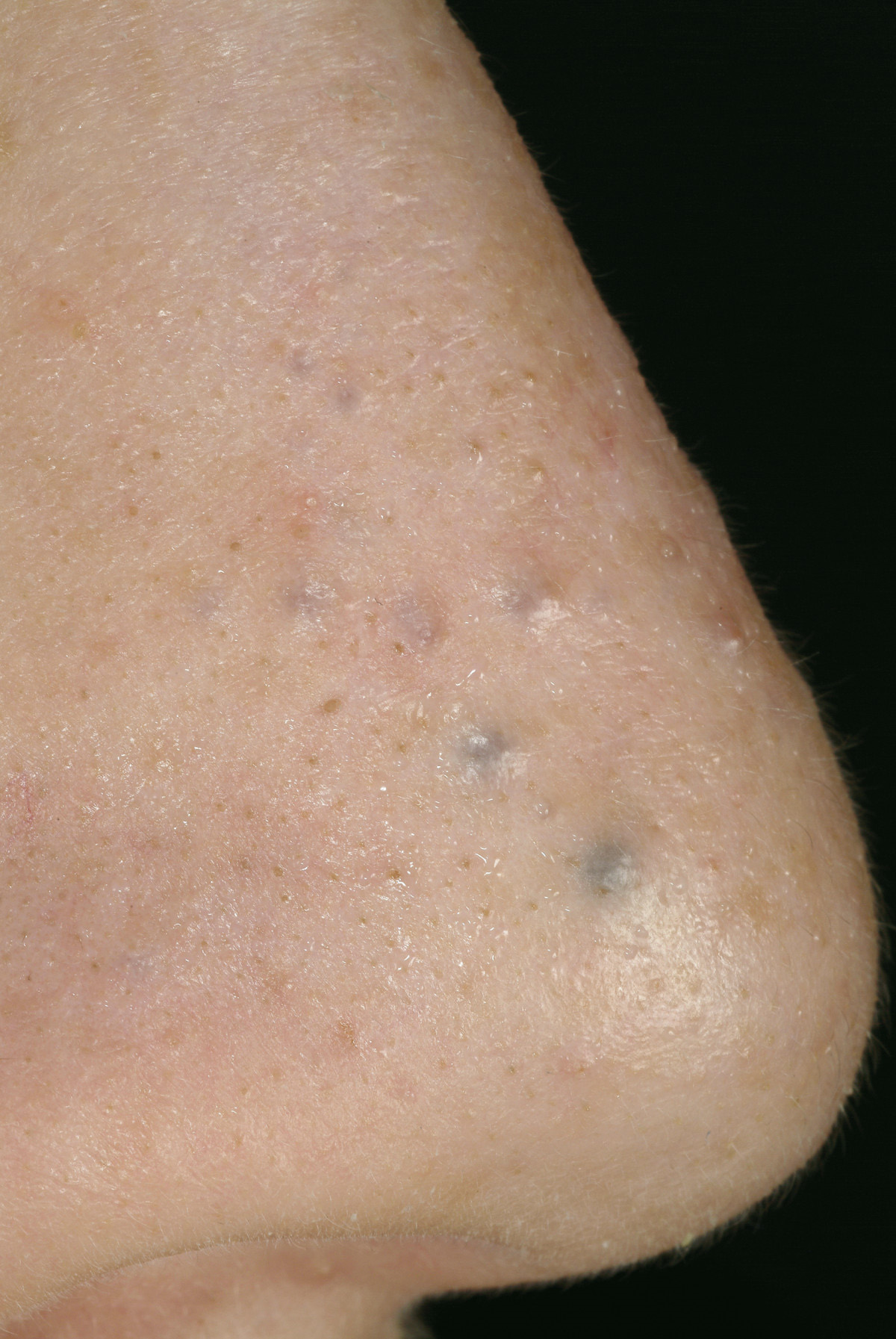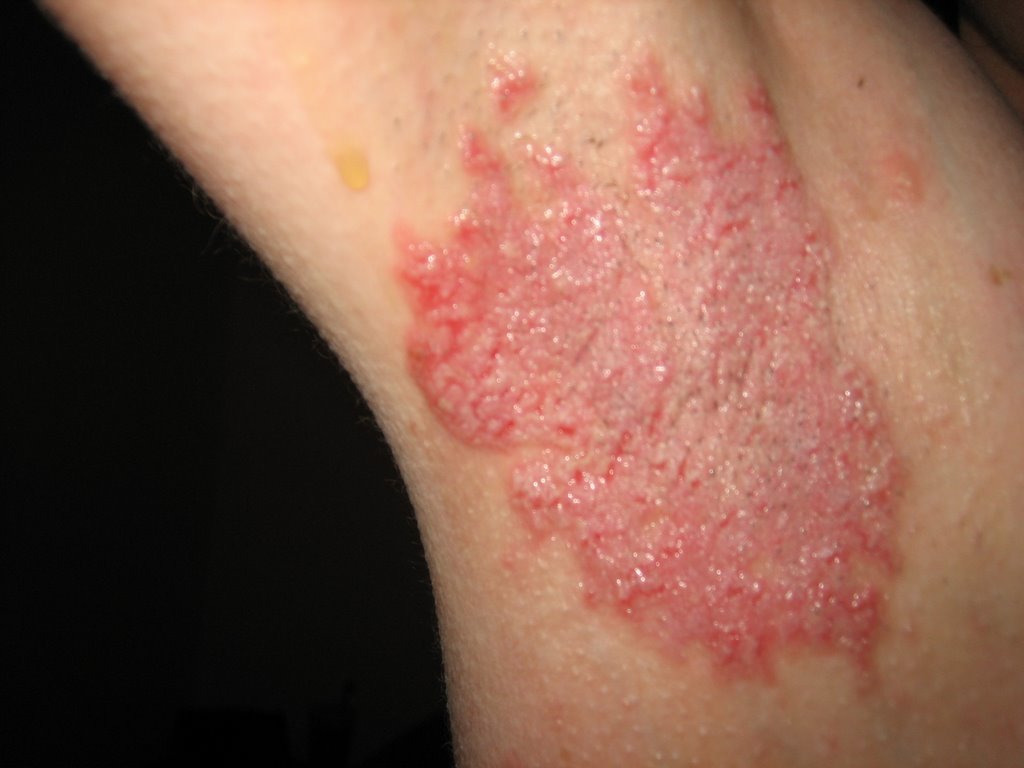|
Syringoma
Syringomas are benign tumor, benign eccrine sweat gland, eccrine sweat duct tumors, typically found clustered on eyelids, although they may also be found in the armpits, abdomen, chest, neck, scalp, or groin area, including genitals, in a symmetric pattern. They are skin-colored or yellowish firm, rounded bumps, 1–3 mm in diameter, and may be confused with xanthoma, Milium (dermatology), milia, hidrocystoma, trichoepithelioma, and xanthelasma. They are more common in women and are most commonly found in middle-aged Asian women. While they can present at any time in life, they typically present during adolescence. They are usually not associated with any other symptoms, although can sometimes cause itchiness or irritation. Types * The eruptive form typically presents on the anterior chest, abdomen, neck, and arms. It presents in successive crops with periods of relief in between times of active rash. * The Milium (dermatology), milia-like type of syringoma is typically ... [...More Info...] [...Related Items...] OR: [Wikipedia] [Google] [Baidu] |
Hidrocystoma
Hidrocystoma (also known as cystadenoma, a Moll's gland cyst, and a sudoriferous cyst) is an adenoma of the sweat glands.Freedberg, et al. (2003). ''Fitzpatrick's Dermatology in General Medicine''. (6th ed.). McGraw-Hill. . Hidrocystomas are Cyst, cysts of sweat ducts, usually on the Eyelid, eyelids. They are not tumours (a similar-sounding lesion called Hidradenoma, hidroadenoma is a benign tumour). The three types of "Perspiration, sweat" glands are: True sweat glands or eccrine glands, Sebaceous gland, sebaceous glands, which have an oily secretion around Hair follicle, hair follicles, and apocrine glands, which have more oily product than eccrine glands and are found on the face, Axilla, armpit, and groin. Hidrocystomas usually arise from apocrine glands. They are also called cysts of Moll or sudoriferous cysts. A type of hidroadenoma that arises from eccrine glands is uncommon. Other related conditions on the eyelids include chalazion (a granulomatous reaction to sebaceous g ... [...More Info...] [...Related Items...] OR: [Wikipedia] [Google] [Baidu] |
Benign Tumor
A benign tumor is a mass of Cell (biology), cells (tumor) that does not Cancer invasion, invade neighboring tissue or Metastasis, metastasize (spread throughout the body). Compared to Cancer, malignant (cancerous) tumors, benign tumors generally have a slower Cell growth, growth rate. Benign tumors have relatively well Cell differentiation, differentiated cells. They are often surrounded by an outer surface (fibrous sheath of connective tissue) or stay contained within the epithelium. Common examples of benign tumors include Melanocytic nevus, moles and uterine fibroids. Some forms of benign tumors may be harmful to health. Benign tumor growth causes a Mass effect (medicine), mass effect that can compress neighboring tissues. This can lead to nerve damage, blood flow reduction (Ischaemia, ischemia), tissue death (necrosis), or organ damage. The health effects of benign tumor growth may be more prominent if the tumor is contained within an enclosed space such as the cranium, respir ... [...More Info...] [...Related Items...] OR: [Wikipedia] [Google] [Baidu] |
Symptom
Signs and symptoms are diagnostic indications of an illness, injury, or condition. Signs are objective and externally observable; symptoms are a person's reported subjective experiences. A sign for example may be a higher or lower temperature than normal, raised or lowered blood pressure or an abnormality showing on a medical scan. A symptom is something out of the ordinary that is experienced by an individual such as feeling feverish, a headache or other pains in the body, which occur as the body's immune system fights off an infection. Signs and symptoms Signs A medical sign is an objective observable indication of a disease, injury, or medical condition that may be detected during a physical examination. These signs may be visible, such as a rash or bruise, or otherwise detectable such as by using a stethoscope or taking blood pressure. Medical signs, along with symptoms, help in forming a diagnosis. Some examples of signs are nail clubbing of either the fingernail ... [...More Info...] [...Related Items...] OR: [Wikipedia] [Google] [Baidu] |
Clear Cell
In histology, a clear cell is a cell that shows a clear cytoplasm when stained with hematoxylin and eosin (H&E). Normal histology In the skin, some secretory cells in the epithelium appear as clear cells, and are one of the components of eccrine sweat glands. A clear cell's plasma membrane is highly folded, more so on the apical and lateral surfaces. The cytoplasm of clear cells contains large amounts of glycogen and many mitochondria. Melanocytes appear as clear cells when in the stratum basale of the skin, and Langerhans' cells appear as clear cells in the stratum spinosum. C cells, more commonly referred to as parafollicular cells are type of cell found in the thyroid gland which stain clear using H&E. Clear cell cancers The clear appearance is often due to the accumulation of substances like glycogen, lipids, or mucin within the cells. This can be a sign of high metabolic activity, which is common in cancer cells as they rapidly grow and divide. Neoplastic clear cells can ... [...More Info...] [...Related Items...] OR: [Wikipedia] [Google] [Baidu] |
Nicolau–Balus Syndrome
Nicolau–Balus syndrome is a cutaneous condition characterized by syringomas and milia. See also * Parry–Romberg syndrome * List of cutaneous conditions Many skin conditions affect the human integumentary system—the organ system covering the entire surface of the Human body, body and composed of Human skin, skin, hair, Nail (anatomy), nails, and related muscle and glands. The major function o ... * List of cutaneous neoplasms associated with systemic syndromes References Connective tissue diseases Syndromes {{Cutaneous-condition-stub ... [...More Info...] [...Related Items...] OR: [Wikipedia] [Google] [Baidu] |
Brooke–Spiegler Syndrome
CYLD cutaneous syndrome (CCS) encompasses three rare inherited cutaneous adnexal tumor syndromes: multiple familial trichoepithelioma (MFT1) (also termed epithelioma adenoides cysticum and epithelioma adenoides cysticum of Brooke), Brooke–Spiegler syndrome (BSS), and familial cylindromatosis (FC). Cutaneous adnexal tumors are a large group of skin tumors that consist of tissues that have differentiated (i.e. matured from stem cells) towards one of the four primary adnexal structures found in normal skin: hair follicles, sebaceous sweat glands, apocrine sweat glands, and eccrine sweat glands. CCS tumors are hair follicle tumors. Individuals with the MFT1, BSS, and FC forms of CCS carry a germline (i.e. present in the germ cells which give rise to an individual) mutation in one of their two '' CYLD'' (i.e. CYLD lysine 63 deubiquitinase) genes. These individuals have skin tumors that tend to cluster into MFT1, BSS, and/or FC types that differ from each other in their locations, o ... [...More Info...] [...Related Items...] OR: [Wikipedia] [Google] [Baidu] |
Diabetes Mellitus
Diabetes mellitus, commonly known as diabetes, is a group of common endocrine diseases characterized by sustained hyperglycemia, high blood sugar levels. Diabetes is due to either the pancreas not producing enough of the hormone insulin, or the cells of the body becoming unresponsive to insulin's effects. Classic symptoms include polydipsia (excessive thirst), polyuria (excessive urination), polyphagia (excessive hunger), Weight loss#Unintentional, weight loss, and blurred vision. If left untreated, the disease can lead to various health complications, including disorders of the Cardiovascular disease, cardiovascular system, Diabetic retinopathy, eye, Diabetic nephropathy, kidney, and Diabetic neuropathy, nerves. Diabetes accounts for approximately 4.2 million deaths every year, with an estimated 1.5 million caused by either untreated or poorly treated diabetes. The major types of diabetes are Type 1 diabetes, type 1 and Type 2 diabetes, type 2. The most common treatment for ty ... [...More Info...] [...Related Items...] OR: [Wikipedia] [Google] [Baidu] |
Blister
A blister is a small pocket of body fluid (lymph, serum, plasma, blood, or pus) within the upper layers of the skin, usually caused by forceful rubbing (friction), burning, freezing, chemical exposure or infection. Most blisters are filled with a clear fluid, either serum or plasma. However, blisters can be filled with blood (known as "blood blisters") or with pus (for instance, if they become infected). Smaller blisters are called ''blebs''. The word "blister" entered English in the 14th century. It came from the Middle Dutch and was a modification of the Old French , which meant a leprous nodule—a rise in the skin due to leprosy. In dermatology, the words cutaneous condition#Vesicle, ''vesicle'' and ''bulla'' refer to blisters of smaller or greater size, respectively. Some sources recommend not to pop a blister. If popped, bacteria can enter. Excess skin should not necessarily be removed as the top layer protects the soft tissue underneath. However, some sources a ... [...More Info...] [...Related Items...] OR: [Wikipedia] [Google] [Baidu] |
Hailey–Hailey Disease
Hailey–Hailey disease (HHD), or familial benign chronic pemphigus or familial benign pemphigus, was originally described by the Hailey brothers (Hugh Edward and William Howard) in 1939. It is a genetic disorder that causes blisters to form on the skin. Signs and symptoms HHD is characterized by outbreaks of rashes and blisters on the skin. Affected areas of skin undergo repeated blistering and inflammation, and may be painful to the touch. Areas where the skin folds, as well as the armpits, groin, neck, buttocks and under the breasts are most commonly affected. In addition to blistering, other symptoms which accompany HHD include acantholysis, erythema and hyperkeratosis. It typically begins in late teenage years or in a person's 30s or 40s. Causes The cause of the disease is a haploinsufficiency of the enzyme ATP2C1; the ATP2C1 gene is located on chromosome 3, which encodes the protein Secretory Pathway Ca²⁺ ATPase, hSPCA1. A mutation on one copy of the gene causes only hal ... [...More Info...] [...Related Items...] OR: [Wikipedia] [Google] [Baidu] |
Syndrome
A syndrome is a set of medical signs and symptoms which are correlated with each other and often associated with a particular disease or disorder. The word derives from the Greek language, Greek σύνδρομον, meaning "concurrence". When a syndrome is paired with a definite cause this becomes a disease. In some instances, a syndrome is so closely linked with a pathogenesis or cause that disease#Terminology, the words ''syndrome'', ''disease'', and ''disorder'' end up being used interchangeably for them. This substitution of terminology often confuses the reality and meaning of medical diagnoses. This is especially true of heredity, inherited syndromes. About one third of all phenotypes that are listed in Online Mendelian Inheritance in Man, OMIM are described as dysmorphic, which usually refers to the facial gestalt. For example, Down syndrome, Wolf–Hirschhorn syndrome, and Andersen–Tawil syndrome are disorders with known pathogeneses, so each is more than just a set of sig ... [...More Info...] [...Related Items...] OR: [Wikipedia] [Google] [Baidu] |



